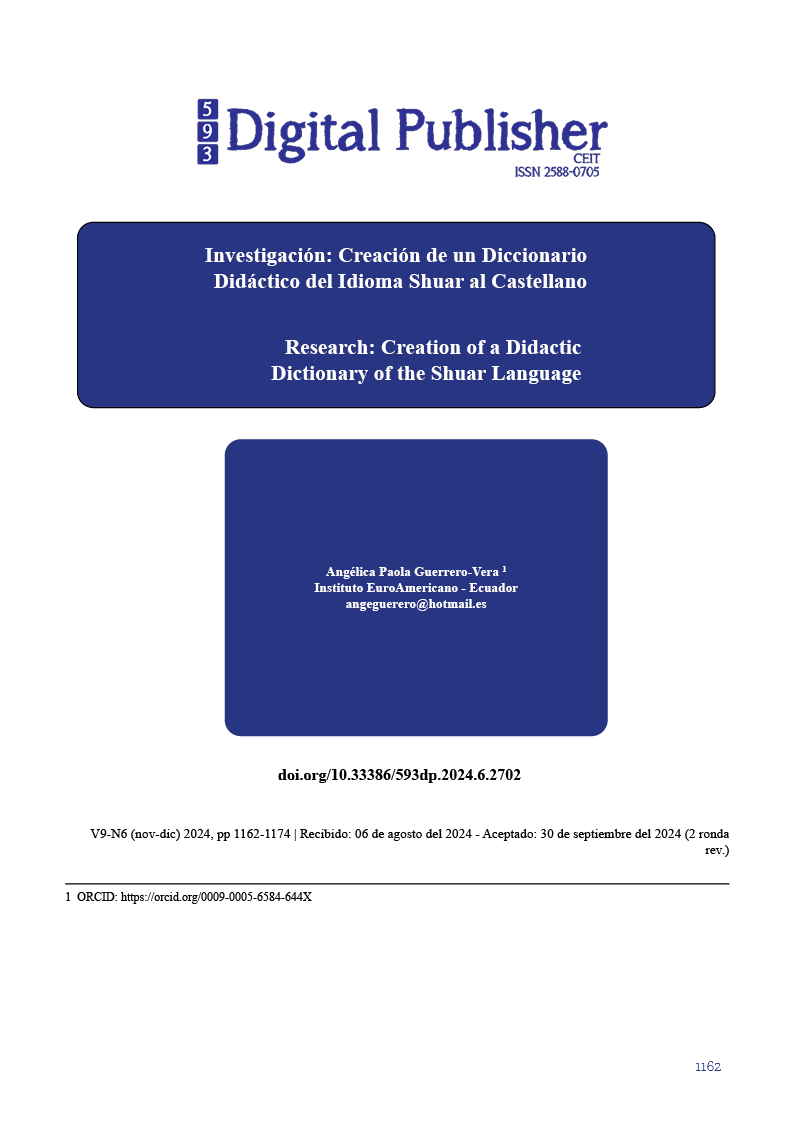Creation of a Didactic Dictionary of the Shuar Language
Main Article Content
Abstract
The research project consists of the creation of a didactic dictionary from the Shuar language to Spanish, developed in the context of the Shuar community of the Bucay canton, which seeks to take advantage of tourism as an opportunity to promote and preserve the Shuar language and culture. The Shuar language, spoken by some members of the community, is in danger of disappearing due to the lack of policies and actions for its promotion and teaching. The didactic dictionary will focus on offering clear and simple explanations of words and expressions in Shuar, with contextualized examples of use, which will allow the youngest members of the community to continue learning and practicing the language, thus enriching their cultural identity and promoting its appreciation and preservation as a language and culture. The research is framed as applied research, with the practical objective of solving the problem of the loss of the Shuar language and improving the expression of the pluricultural identity of the community. The justification for the project lies in the need to preserve and promote the Shuar language and culture, which has a significant presence in the Amazon region and has been recognized as an official language in the Constitution of Ecuador in 2008.
Downloads
Article Details

This work is licensed under a Creative Commons Attribution-NonCommercial-ShareAlike 4.0 International License.
1. Derechos de autor
Las obras que se publican en 593 Digital Publisher CEIT están sujetas a los siguientes términos:
1.1. 593 Digital Publisher CEIT, conserva los derechos patrimoniales (copyright) de las obras publicadas, favorece y permite la reutilización de las mismas bajo la licencia Licencia Creative Commons 4.0 de Reconocimiento-NoComercial-CompartirIgual 4.0, por lo cual se pueden copiar, usar, difundir, transmitir y exponer públicamente, siempre que:
1.1.a. Se cite la autoría y fuente original de su publicación (revista, editorial, URL).
1.1.b. No se usen para fines comerciales u onerosos.
1.1.c. Se mencione la existencia y especificaciones de esta licencia de uso.
References
(2022). Obtenido de Real Academica Española: https://dle.rae.es/diccionario?m=form Amodio, E. (1986). Centro de Documentación CIDAP. Obtenido de
Ausubel, D. P. (1968). Educational psychology: A cognitive view. Holt, Rinehart and Winston.
Banks, J. A. (1993). Multicultural education: Characteristics and goals. In J. A. Banks & C. A. McGee-Banks (Eds.), Multicultural education: Issues and perspectives (pp. 3-30). Allyn & Bacon.
Blásquez , N., Flores, F., & Ríos , M. (2012). Investigación feminista de epistemologia, metodología y representaciones sociales. Ciudad de México: Colección, debate y reflexión. Obtenido de https://biblioteca.clacso.edu.ar/Mexico/ceiich- unam/20170428032751/pdf_1307.pdf
Carneiro , R., Toscano, J., & Díaz , T. (2021). Los desafíos de las TIC para el cambio educativo. Metas educativas. Obtenido de https://www.oei.es/uploads/files/microsites/28/140/lastic2.pdf
chrome- extension://efaidnbmnnnibpcajpcglclefindmkaj/https://www.scielo.br/j/ha/a/bPNDRq nv5mDzhQy54zVDbvF/?format=pdf&lang=es
Clacso. (2008). Consejo Latinoamericano de Ciencias Sociales. Obtenido de https://biblioteca.clacso.edu.ar/clacso/osal/20190430043952/Ecuador_2008.pdf
Constitucion del Ecuador. (2008). Obtenido de https://pdba.georgetown.edu/Parties/Ecuador/Leyes/constitucion.pdf
Di Caudo, M., & Llanos , D. (2016). Interculturalidad y educación desde el sur. En Contextos, experiencias y voces (págs. 8-12). Obtenido de https://biblioteca.clacso.edu.ar/clacso/se/20161004101819/Interculturalidad_y_educac ion.pdf
Federación Shuar. (2023). Estructura socioeconómica y preservación cultural en la comunidad Shuar.
Freire, P. (1970). Pedagogy of the oppressed. Continuum.
http://documentacion.cidap.gob.ec/cgi-bin/koha/opac-detail.pl?biblionumber=3054 Asamblea Nacional del Ecuador. (2021). Ministerio de Defensa del Ecuador. Obtenido de
https://www.defensa.gob.ec/wp-content/uploads/downloads/2021/02/Constitucion-de- la-Republica-del-Ecuador_act_ene-2021.pdf
JARRIN, A. C. (2019). Obtenido de http://dspace.utb.edu.ec/bitstream/handle/49000/6944/E- UTB-FCJSE-HTURIS-000097.pdf?sequence=1&isAllowed=y
Ministerio de Turismo. (2023). Turismo cultural y preservación de las lenguas indígenas en Ecuador.
Obtenido de http://www.economia.unam.mx/assets/pdfs/libros/capitalismo/Elcapitalismoainiciosde lsigloXXI.pdf
Real Academica Española. (2022). Obtenido de Real Academica Española: https://dle.rae.es/diccionario?m=form
Revista Yachaikuna. (2001). Obtenido de chrome- extension://efaidnbmnnnibpcajpcglclefindmkaj/http://www.icci.nativeweb.org/yachai kuna/1/mejeant.pdf
Rivera, M., & Andrade , A. (2019). Facultad de economía Universidad Autónoma de México.
Secretaría Técnica de circunscripción territorial especial Amazónica. (2022). Secretaría de la Amazonía. Obtenido de https://www.secretariadelamazonia.gob.ec/wp- content/uploads/downloads/2022/08/Proy_-Programa_desarrollo_Ctea_act_2022.pdf
Sherzer, J. (2000). Una aproxtmacion a la lengua y a la cultura centrada en el discurso’.
Talavera, A. S. (2003). TURISMO CULTURAL, CULTURAS TURÍSTICAS. Obtenido de
Unesco. (2004). Biblioteca Digital UNESDOC. Obtenido de https://unesdoc.unesco.org/ark:/48223/pf0000150169
Utitiaj, J. (2023). https://dspace.ups.edu.ec/bitstream/123456789/25043/1/UPS- CT010582.pdf. Obtenido de https://dspace.ups.edu.ec
Valarezo, R. (2019). Interculturalidad y su aporte para los proyectos de desarrollo. En Territorio, identidad e interculturalidad (págs. 25-26). Abya Yala. Obtenido de https://biblio.flacsoandes.edu.ec/libros/digital/57514.pdf


